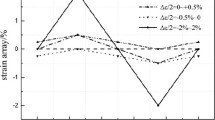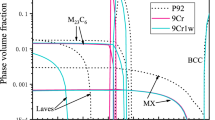Abstract
Intragranular embrittlement is key to the weakening of properties of ultra-supercritical applied materials as HR3C heat-resistant steel in service and is considered to be related to the structure of grain boundary and the precipitation of carbides. In this work, the structural unit model was applied to study the structure of grain boundary and carbide formation with molecular dynamics simulation, and then, the precipitation tendency of carbides was analyzed through the structural similarity between grain boundary and carbide by using radial distribution function of the metal atom. At the same time, an electron backscatter diffraction study on serviced and treated HR3C heat-resistant steel was used for experimental exploration. Results show that the structural similarity between grain boundary and carbide depends on the grain boundary angle, wherein the structural similarity between grain boundary and carbide is higher for the grain boundary angle of 20–50°, while it is lower at the grain boundary angle close to 60° or smaller than 20°. The structure of Cr23C6 and Cr7C3 carbides is more similar to the local structure of grain boundary than that of Cr3C2 carbide. The grain boundary angle study on HR3C heat-resistant steel shows that the high content of 20–50° grain boundary indeed increases the precipitation of carbides, which is proposed to reduce the proportion of 20–50° grain boundaries by a proper procedure of cold deformation + heat treatment as 20% + 900 °C/6 h.












Similar content being viewed by others
References
Zheng ZJ (2011) The analysis of considerably reduction to HR3C’s aging impact ductility. Boiler Technol 42(4):46–48
Raabe D, Herbig M, Sandlöbes S, Li Y, Tytko D, Kuzmina M, Pnge D, Choi P-P (2014) Grain boundary segregation engineering in metallic alloys: a pathway to the design of interfaces. Curr Opin Solid State Mater Sci 18:253–261
Li H, Liu XR, Zhang K, Liu WQ, Xia S, Zhou BX (2019) Effects of the triple junction types on the grain boundary carbide precipitation in a nickel-based superalloy, a statistical analysis. Philos Mag 99(3):318–327
Jones R, Randle V, Owen G (2008) Carbide precipitation and grain boundary plane selection in overaged type 316 austenitic stainless steel. Mater Sci Eng A 496:256–261
Hong H, Rho B, Nam S (2001) Correlation of the M23C6 precipitation morphology with grain boundary characteristics in austenitic stainless steel. Mater Sci Eng, A 318:285–292
Watanabe T (1985) Structural effects on grain boundary segregation, hardening and fracture. J Phys Colloq 46(C4):C4555–C4566
Lee KC, Erb U (2013) Grain boundaries and coincidence site lattices in the corneal nanonipple structure of the Mourning Cloak butterfly. Beilstein J Nanotechnol 4:292–299
Sahu S, Sharma NK, Patel SK, Mondal K, Shekhar S (2019) The effect of grain boundary structure on sensitization behavior in a nickel-based superalloy. J Mater Sci 54:1797–1818. https://doi.org/10.1007/s10853-018-2919-7
Randle V, Owen G (2006) Mechanisms of grain boundary engineering. Acta Mater 54:1777–1783
Deepak K, Mandal S, Athreya CN, Kim DI, De Boer B, Sarma VS (2016) Implication of grain boundary engineering on high temperature hot corrosion of alloy 617. Corros Sci 106:293–297
Randle V (2010) Grain boundary engineering: an overview after 25 years. Mater Sci Technol 26(3):253–261
Zhuo Z, Xia S, Bai Q, Zhou BX (2018) The effect of grain boundary character distribution on the mechanical properties at different strain rates of a 316L stainless steel. J Mater Sci 53(5):2844–2858. https://doi.org/10.1007/s10853-017-1695-0
Detrois M, Goetz RL, Helmink RC, Tin S (2016) The role of texturing and recrystallization during grain boundary engineering of Ni-based superalloy RR1000. J Mater Sci 51(11):5122–5138. https://doi.org/10.1007/s10853-016-9815-9
Watanabe T, Tsurekawa S (1999) The control of brittleness and development of desirable mechanical properties in polycrystalline systems by grain boundary engineering. Acta Metall 47(15):4171–4185
Xu ZF, Ding ZM, Dong LN, Liang B (2016) Characterization of M23C6 carbides precipitating at grain boundaries in 100Mn13 steel. Metall Mater Trans A 49A(10):4862–4868
Li P, Ikeda K, Horiuchi T, Miura S (2018) Laves phase precipitation behavior and the orientation relationship with BCC in Cr–Mo–Nb system. Mater Trans 59(11):1706–1715
Wang R, Dunlop GL (1984) The crystallography of secondary carbide precipitation in high speed steel. Acta Metall 32(10):1591–1599
Bruggeman GA, Bishop GH, Hartt WH (1972) Coincidence and near-coincidence grain boundaries in HCP metals. In: Hu H (ed) The nature and behavior of grain boundaries. Plenum Press, New York, pp 83–122
Sutton AP, Balluffi RW (1995) Interfaces in crystalline materials. Oxford University Press, New York
Gertsman VY, Nazarov AA, Romanov AE, Valiev RZ, Vladimirov VI (1989) Disclination-structural unit model of grain boundaries. Philos Mag A 59(5):1113–1118
Han J, Vitek V, Srolovitz DJ (2017) The grain-boundary structural unit model redux. Acta Mater 133:186–199
Jain* A, Ong* SP, Hautier G, Chen W, Richards WD, Dacek S, Cholia S, Gunter D, Skinner D, Ceder G, Persson KA (*=equal contributions) (2013) The materials project: a materials genome approach to accelerating materials innovation. APL Mater 1(1): 011002.
Davis JR (1997) ASM specialty handbook: heat-resistant materials. ASM International, USA
Villars P, Calvert LD (1985) Pearson's handbook of crystallographic data for intermediate phases. American Society of Metals, Cleveland, OH
Randle V (2001) Grain boundary geometry: measurement. In: Buschow KHJ, Cahn RW, et al. (eds) Encyclopedia of materials: science and technology, 2nd edn. Pergamon, Oxford, pp 3618–3622
Morawiec A (2004) Orientations and rotations: computations in crystallographic textures. Springer, Berlin
Thompson William J (2004) Angular momentum: an illustrated guide to rotational symmetries for physical systems. Wiley, Weinheim
Hao YP, Tan CW, Yu XD, Chen R, Nie ZH, Ren Y, Yang SR, Li Y, Wang F (2020) Effect of grain boundary misorientation angle on diffusion behavior in molybdenum-tungsten systems. J Alloy Compd 819:152975
Dong RF, Li JS, Zhang T, Hu R, Kou HC (2016) Elements segregation and phase precipitation behavior at grain boundary in a Ni-Cr-W based superalloy. Mater Charact 122:189–196
Huang WJ, Yuan SS, Chai LJ, Jiang LY, Liu HD, Wang FJ, Wang DZ, Wang JJ (2019) Development of grain boundary character distribution in medium-strained 316L stainless steel during annealing. Met Mater Int 25:364–371
Yin AM, Wang YF, Shu XD, Zhu ZG, Peng H (2019) Grain boundary distribution evolution of 00Cr12Ti FSS during annealing. J Wuhan Univ Technol 34(4):932–940
Funding
This study was funded by the National Natural Science Foundation of China (Grant Nos. U1610256, 51901035 and 51771042), the National High Technology Research and Development Program of China (The 863 Program) (Grant No. 2015AA034402) and the Dalian University of Technology Fundamental Research Fund (Grant No. DUT19RC(4)010).
Author information
Authors and Affiliations
Corresponding author
Ethics declarations
Conflict of interest
The authors declare that they have no conflict of interest.
Additional information
Publisher's Note
Springer Nature remains neutral with regard to jurisdictional claims in published maps and institutional affiliations.
Rights and permissions
About this article
Cite this article
Cao, T., Cheng, C., Ye, F. et al. Relationship between carbon segregation and the carbide precipitation along grain boundary based on the structural unit model. J Mater Sci 55, 7883–7893 (2020). https://doi.org/10.1007/s10853-020-04537-2
Received:
Accepted:
Published:
Issue Date:
DOI: https://doi.org/10.1007/s10853-020-04537-2




